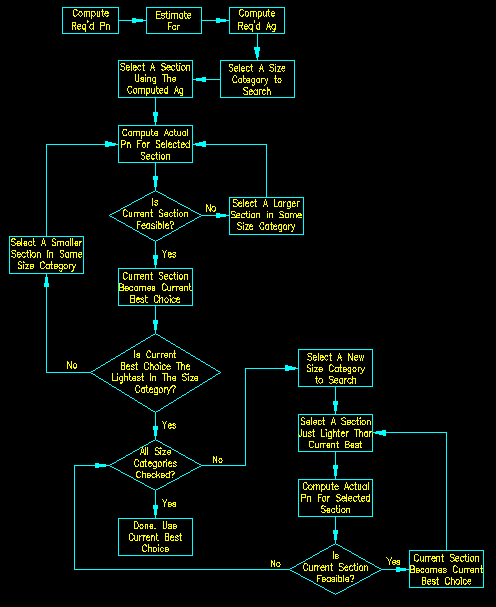|
Limit State of Flexural Buckling for Compact and Non-compact Sections |
|
|
Section 7.6
Selecting Sections
Last Revised: 11/04/2014
The procedure for selecting a section for a compression member is complicated by the fact that the strength of the members is a function of both the cross sectional area and the slenderness. Consequently, it is virtually impossible to definitively solve for a required section property so that you can directly select the best section from the table without iteration.
The method you use to select your member will probably be influenced by whether you are doing the problem by hand or by computer spreadsheet.
It should be noted, that among W sections, most of the sections from W8 to W14 were designed with columns in mind. They are short and wide, giving values for rx and ry that are more equal (i.e. rx/ry approaches 1.0) so that the slenderness ratios in each principle plane are likely to be near in value. Sections in larger size categories are deeper and narrower, making them very useful as beam sections, but not so useful as column sections since they are only strong in one direction without adding extra lateral support in the weak direction. With this in mind, most W shape columns will only be W14 or smaller sections.
A Manual Method
First, determine the Pn that is required for your situation.
Pn > Pu / fc or Pn > Wc Pa
Depending on the design philosophy that you are using.
It is also true that
Pn = Fcr Ag
You know that Fcr is going to be somewhere between 0 and Fy. If the member is likely to be very slender, then the value of Fcr will be lower rather than higher. So, make a guess concerning the value of Fcr. The actual value you guess is only important in the fact that an accurate guess will get you closer to your final answer and reduce the number of iterations required to arrive at the best solution. You will still arrive at the same solution regardless of the initial guess of Fcr. The actual Fcr is computed once a member is selected.
With your estimated Fcr, compute a required Ag. Search the tables for a section with an Ag approximately equal to the one that you computed.
Now, with an actual section selected, compute it's actual nominal strength, Pn, for you particular conditions. This will require computing the actual value of Fcr for the section selected. Do not use your initial Fcr estimate! It is quite likely that the section will be either significantly over or under capacity.
At this point, search one size category (i.e. W8, W10, W12, or W14) to find the lightest section in the category that satisfies the strength criteria. Next look at sections that are lighter than your current best choice in the other size categories to see if there is a better choice in any of the categories. Figure 7.6.1 is a flow chart illustrating the procedure.
Figure 7.6.1
Flow Chart of Selection Procedure
You can also use this method by manually entering the associated section properties manually (or by judicious use of the spreadsheet steel tables that were included with your SCM CD) into an analysis spreadsheet of your own making.
Computer Methods
There are probably a thousand different approaches that you can take to search the section tables if you are adept at using spreadsheets. Even more efficient would be making use of computer programming either within or outside of you spreadsheet to conduct the search. Most spreadsheet programs incorporate Visual Basic for Applications (VBA) or some other language that makes programming search algorithms possible and is not too difficult.
One method is to conduct a search similar to the one described above as a hand method.
Other methods involve exhaustive search of the table (an easy task for a computer but computationally inefficient) or devising some other search algorithm.
One spreadsheet approach is to compute the strengths for all sections in the tables then sort to find the lightest. This is a fairly easy and straight forward approach.
In the end, you only need to show that your final selection satisfies all applicable limit states.
